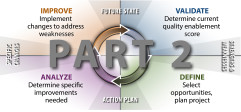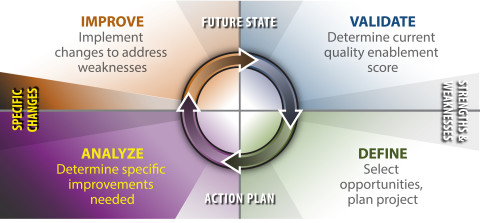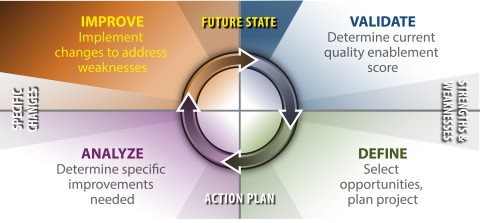… Is Implemented With a Plan (Part 2)

“Knowing is not enough; we must apply. Willing is not enough; we must do.”
Johann Wolfgang von Goethe
Last week, we started the discussion of the QE Cycle, and covered the first two phases – Validate and Define. This week, we complete the overview with the last two phases – Analyze and Improve.
QE Cycle – Part 2
Analyze

It’s in this phase that we identify the causes of the low QE scores. Think of it this way – the QE Score reflects the symptoms, and we need to understand the root causes to fix the problem.
- Initialization – We meet with the project team and make sure all members are in sync with the Project Charter and other deliverables from the Checkpoint meeting, and validate that they can commit the time required to the project. If not, then the Sponsor will need to be informed and adjustments made.
- Process and Tools – As with Define, the specific processes and tools will usually be determined by the organization’s PLC; those listed below are from the six sigma toolbox.
- Current process maps for the targeted processes – These may already exist; if they do, then they will need to be validated with current process users. A SIPOC (Source-Input-Process-Output-Customer) is quite valuable here.
- Current stakeholder input – This will validate how well the current processes meet the stakeholder needs (six sigma voice of the customer) and identify what is really important to them (six sigma Critical to Quality measures).
- Baseline measures, based on what’s important to the stakeholders, for each process under discussion. We’ll use those to determine the success of our improvements.
- We may use other standard process improvement tools, such as cause and effect (Ishikawa) diagrams, cost of poor quality analysis, and various statistical tools.
- Deliverables – We need to identify improvements needed (the “what”), but not necessarily the details of the improvement methodology (the “how”). That will come in the next phase. We also need to update the cost-benefit analysis, now that we have more details. This will include the cost of any external resources needed.
- Checkpoint – This checkpoint involves more than the prior two from a decision perspective. The prior two were a bit easier, and will usually result in a go-forward decision. In this checkpoint, we’ll be discussing specific changes (“what”), and the implementation may require external expertise. The organization will need to examine their in-house expertise, and determine if they need to hire outside consultants. For example, if Metrics is an identified area, then an external metrics consultant may be needed.
Improve

We implement the changes identified in the Analyze phase.
- Initiation – We’ll need to identify any external resources needed, and get them through the contracting process. We’ll also most likely need to extend either the core project team or the list of engaged supporters.
- Process and Tools – The process and tools used will usually include the following:
- Process mapping process and tools, to clearly define future process.
- External resource sourcing, to identify and hire any external resources needed.
- Brainstorming, to identify potential solutions.
- Decision-making tools, such as decision and prioritization matrices.
- Pilots are often useful to shake out a new process and make improvements prior to broad implementation.
- Organizational change management, to properly roll out the changes.
- Deliverables – As always, a function of PLC, but should include:
- Future (“To-Be”) process map, which will, in conjunction with the initial process map, help define the specific changes, and leave behind an accurate expected process flow.
- Updated implemented costs, which will depend on any external resources used for the implementation.
- Updated project plan documents to include any external resources and their plans / schedules.
- Updated risk analysis.
- Presentation materials to inform the organization and other stakeholders of the changes that will be made.
- Recommendations for next steps – do we want to do another cycle? We probably only addressed the highest-priority opportunities so far, and there are probably other areas that should be addressed.
- Checkpoint – The timing of this checkpoint is a bit more fluid than the first three. While we want to release most of the project team back to theirprevious jobs, we won’t really know how successful the changes are until we’ve seen them fully implemented and had time to measure the results. So we may want to hold two checkpoints:
- First, once the pilot projects are completed, meet with the Checkpoint Committee to give them the latest results and plans; and
- After the process changes have been fully implemented, then update the metrics with organization results and review them with the Checkpoint Committee.
- At one of these meetings, the decision needs to be made to either start another process or not.
What’s Next
Next week, we’ll start the detailed discussions needed to calculate a QE Score with the specific Subject Areas and Discussion Points in the People dimension.
Until Then …
“A man’s judgment is no better than his information.”
Anonymous

What are your thoughts? Please share your comments in the block below.